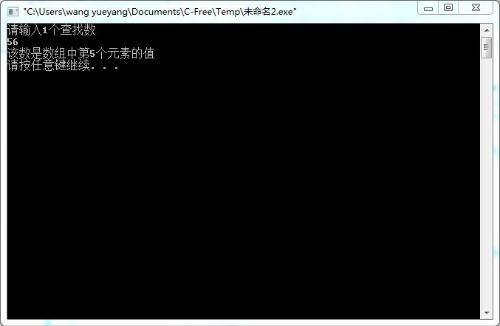[怎么用VS2010写C语言程序]如何使用Visual Studio 2010(VS2010)编译C语言 1.打开VS2010主界面,然后选择,文件→新建→项目,在项目类型中选择VC++→win32 然后在右侧模板中选择win32控制台应用程序,再在下...+阅读
//代码如下
# include "stdio.h" void main() { printf("\n\n请输入命令,Y,是文字提示,A,B为命令,N为退出程序:"); while
(1){ char c1; scanf("%c",&c1); if(c1!='\n'){ if(c1=='Y'){ printf("恭喜您输入了Y!"); }else if(c1=='A'){ printf("\n恭喜您输入了A,执行了A计划!"); }else if(c1=='B'){ printf("\n恭喜您输入了B,执行了B计划!"); }else if(c1=='N'){ printf("\n恭喜您输入了N,程序即将退出!\n"); break; }else{ printf("\n输入错误!\n"); continue; } }else{ continue; } printf("\n\n请输入命令,Y,是文字提示,A,B为命令,N为退出程序:"); } }
这样的C程序怎么编
#include#include#include/* 每行最大数据数 */ #define MAX_NUM 80 /* 分页的行数,每次读了MAX_LINE行数据之后写入临时文件 */ #define MAX_LINE 2 /* 临时文件的前缀 */ #define TMP_FILE_NAME_PRE "text2.log.temp" void err_exit(const char *info, int exit_code) { puts(info); exit(exit_code); } int main() { FILE *in, *out, *out_tmp; char str_data[MAX_LINE][MAX_NUM]; /* 最大读取内存 */ char tmp_file[256]; /* 保存临时文件名 */ int line_id; /* 读取的行数 */ int i; int seq_flag; /* 分页数,即临时文件数 */ line_id = seq_flag = 0; if ( (in=fopen("text1.log", "r")) == 0) err_exit("Can't open file - text1.log\n", 1); if ( (out=fopen("text2.log", "w")) == 0) { fclose(in); err_exit("Can't create file - text2.log\n", 2); } /* 逐行读取, 不为0时正常读入 */ while (fgets(str_data[line_id++], MAX_NUM, in) != 0) { if (feof(in)) break; /* 读完,退出 */ if (line_id == MAX_LINE) { /* 读取行数到最大行数,将已读数据写入文件 */ line_id = 0; /* 重置读取行数为0 */ snprintf(tmp_file, 256, TMP_FILE_NAME_PRE "%d", seq_flag++); /* 设置临时文件名=临时文件前缀+分页ID */ /* 创建 */ if ((out_tmp = fopen(tmp_file, "w")) == 0) { fclose(in); fclose(out); remove("text2.log"); err_exit("Can't create temp file...", 3); } /* 将已读数据逆序写入临时文件 */ for (i=MAX_LINE-1; i>-1; --i) { fputs(str_data[i], out_tmp); } fclose(out_tmp); /* 关闭文件 */ } } fclose(in); /* 数据已读完,关闭in */ /* 检测语句是否以\n结束...此句用检测不以\n结束的原文件 */ /* 提出原文件的最后一句,检测是否以\n结束,如果不以\n结束,写入新文件时添加\n */ if (line_id - 1 >-1) { fputs(str_data[line_id-1], out); if (str_data[line_id - 1][strlen(str_data[line_id - 1]) - 1] != '\n') { fputs("\n", out); } } /* 从倒数第二句继续写入 */ for (i=line_id-2; i>-1; --i) { fputs(str_data[i], out); } /* 若之前有产生临时文件,读取临时文件的内存并写入目标文件,同时删除临时文件 */ while (seq_flag-- >0) { snprintf(tmp_file, 256, TMP_FILE_NAME_PRE "%d", seq_flag); /* 最后一个临时文件 */ in = fopen(tmp_file, "r"); /* 打开临时文件....此处未进行检测... */ /* 读取并写入 */ while (fgets(str_data[0], MAX_NUM, in) != 0) fputs(str_data[0], out); fclose(in); remove(tmp_file); /* 删除临时文件... */ } fclose(out); printf("DONE...\n"); } 1
VB TXT读写这样的程序怎么写代码
先说 lxz1969 的回答是有问题的,如果你的文件内容为:
783643,CDEF,123456
123456,ABCD,12
783643,BBCD,8
945325,CBCD,15
他的程序就会出问题,返回第一行的内容,而不是你要的第二行的内容。
另外,如果你的文件里有一行空行,他的程序立即就会崩溃!因为如果r="",则split函数会出错。
我修改一下他的回答,并给你说明
private sub command1_click()
dim r as string,s() as string '尽量不要用 Varient变量,而定义数组s存放每行按","分隔后的各个部分
open "123.txt" for input as #1 '打开文件123.txt,以读入的方式(input),文件号为1
do until eof(1) 'eof(1)表示文件号为1的文件是否读到文件末尾,读到末尾就返回true,表示已经读完文件,until eof(1) 相当于 while not eof(1),即如果没有读完文件就运行下面的循环
line input #1,r '从文件号为1的文件里的当前读取位置读取一行,行内容存入变量r,同时当前读取位置自动指向下一行
if len(r)>0 then '如果r不为空串,才执行下面的语句
s=split(r,",") '按",",把r中的内容分为3部分,以“123456,ABCD,12”行为例,执行此语句后,s(0)="123456", s(1)="ABCD", s(2)="12"
if s(0)=Text1.Text then '这你能明白了吧,如果s(0)是你输入的内容就显示这行的内容
label1.caption=s(0)
label2.caption=s(1)
label3.caption=s(2)
exit do '已经找到并显示出来了,就退出循环
end if
end if
loop
close #1 '关闭文件号为1的文件,以释放资源
end sub
求问这样的程序如何正确运行
如果你存但是汉字我建议你用字符串形式存在好点,这样的话就不会报错,对于汉字和英文(包括数字)他们的存储方式不同,字母用一个字节保存,而汉字用了两个字节保存(short)或者char*prt="你"也行,你可以通过这个方式存,我就是这么做的,但是你真想了解本质的画,我可以告诉你一般的字母用一个字节存就够了,而我们的汉字叫做宽字符(用两个字节存嘛,就认为宽了),因为汉字一级常用3500,二级常用4500,还有很多不常用的,你也要在计算机保存啊,所以就用两个字节来保存汉字,因此保存一个汉字使用的是short或者C/C++标准里有个wchar_t类型,他就是宽字符类型,对应的为了处理宽字符,也有专门的库,你可以 wchar_t 宽字符 就有很多讲解,但是用的多的就是用char字符串保存,因为我们一般的printf之类的函数他既能识别普通字符(char)又能识别宽字符(例如说汉字)。
...
以下为关联文档:
c语言关机程序怎么写//#include "stdafx.h" #include "stdio.h" #include "string.h" #include "stdlib.h" int print() { printf(" ╪╪╪╪╪╪╧╧╧╧╧╧╧╧╪╪╪╪╪╪\n"); printf("╔═══╧╧ C语...
用C语言写一个能够实现四个数排序的程序#include stdio.h void main{ int i,j; int temp; int arr[] = {8,7,9,12}; for(i=0;i<arr.length;i++){ for(j=1;j<arr.length;j++){ if(arr[i]>arr[j]){ temp = arr[i]; a...
用数组的方法实现程序C语言#include<stdio.h> void main() { int i,a,b,c,d; char buffer[256]; gets(buffer); a=b=c=d=0; for ( i=0;i<20;i++ ) if ( (buffer[i]>='a' & buffer[i]<='z')||(buffer[i...
c语言两个矩阵相乘的程序怎么写matrix_mul(int **a, int **b, int **c, int m, int p, int n) { for (int i = 0; i < m; i++) { for (int j = 0; j < p; j++) { c[i][j] = 0; for (int k = 0; k < n; k++...
C语言程序中Sizeof这个语法怎么用sizeof 在 C语言 中 是“运算符”,如同 +-*/ 运算符,不是函数。 检查Int所占的字节数: #include <stdio.h> #include <stdlib.h> void main() { int x; x = sizeof(int); print...
用c语言编译个程序第三题: #include<stdio.h> void main() { int m, n, m1, n1, t; printf("input n,m:"); scanf("%d,%d", &n, &m); if (n < m) { m1 = m; n1 = n; } else { m1 = n; n1 = m; } do...
怎样分解质因数用c语言写程序#include<stdio.h> int main() { int n; scanf("%d",&n); bool b = false; int i = 2; printf("%d = ",n); if (n == 1) printf("1"); while (n > 1) { int num = 0; while (n % i...
用C语言写个简单程序谢谢帮忙!用C语言写个简单程序谢谢帮忙!用C语言编写一段简单的程序作业调度和低级调度算法:void max3(int a,int b, int c); main() { int a,b,c; printf("please input 3 int:"); scanf(...
用C语言编写一个程序用C语言编写一个程序,C语言编写程序:#include <stdio.h> main() { char *month_name[13]={"illegal month","January","February","March","April", "May","June","July","August","September","Oct...




